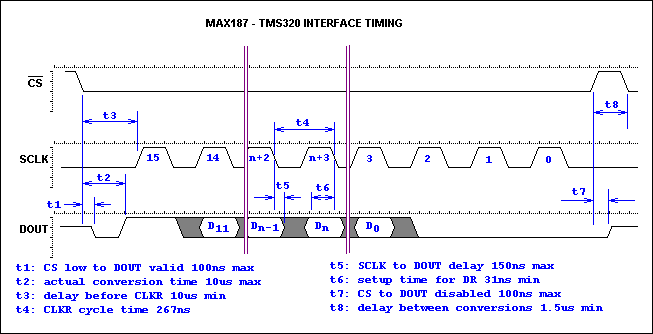
OverviewThe MAX187 12-bit ADC can be interfaced to Texas Instruments' TMS320C30 DSP via serial interface. The interface uses three wires plus ground. This applicaTIon note explains how to interface the MAX187 EvaluaTIon Kit to the TMS320C3X EvaluaTIon Module.
The example program was assembled using the TMS320C3X/4X COFF Assembler Version 4.50 and the TMS320C3X/4F COFF Linker Version 4.50 (the assembler and linker are copyright 1987-1992 Texas Instruments Incorporated).

Figure 1. MAX187-TMS320 interface.

Figure 2. MAX187-TMS320 timing.

Larger image
Figure 3. Listing.
Interfacing the MAX187 EVKIT to the TMS320C3X EVMMaxim's MAX187 Evaluation Kit can be interfaced to Texas Instruments' TMS320C3X Evaluation Module as follows:
- Solder a 2-x-5-pin berg strip into the prototype area. Connect it as indicated in the table below.
- Connect a +5V power supply to the MAX187.
- Use a 10-pin ribbon cable to connect the TMS320C3X EVM to the MAX187EVKIT.
- Run the demo software.
Ribbon-Cable Signals
How It WorksThe demo software configures the TMS320C30 so that FSR1 and DR1 are inputs and CLKR1 and XF1 are outputs. The software uses the XF1 output to initiate a conversion. The XF1 pulse drives the MAX187 chip-select input. The CLKR1 output provides the serial clock to the MAX187. Data output from the MAX187 is received on the DR1 input. The FSR1 Frame Start signal is also tied to the data output, so that the start bit from the MAX187 marks the beginning of the serial frame.
To read the MAX187, the software drives the XF1 output low and then waits 10µsec to allow time for the conversion. Then, the software enables the serial receive clock. The MAX187 sends its start bit, followed by the serial data. The demo software polls the serial receiver until a complete frame has been received. Because only 12 of the 16 bits are significant, the demo software right-justifies the significant bits and removes the start bit; then it writes the 12-bit word to the EVM host data port.
欢迎分享,转载请注明来源:内存溢出

 微信扫一扫
微信扫一扫
 支付宝扫一扫
支付宝扫一扫
评论列表(0条)